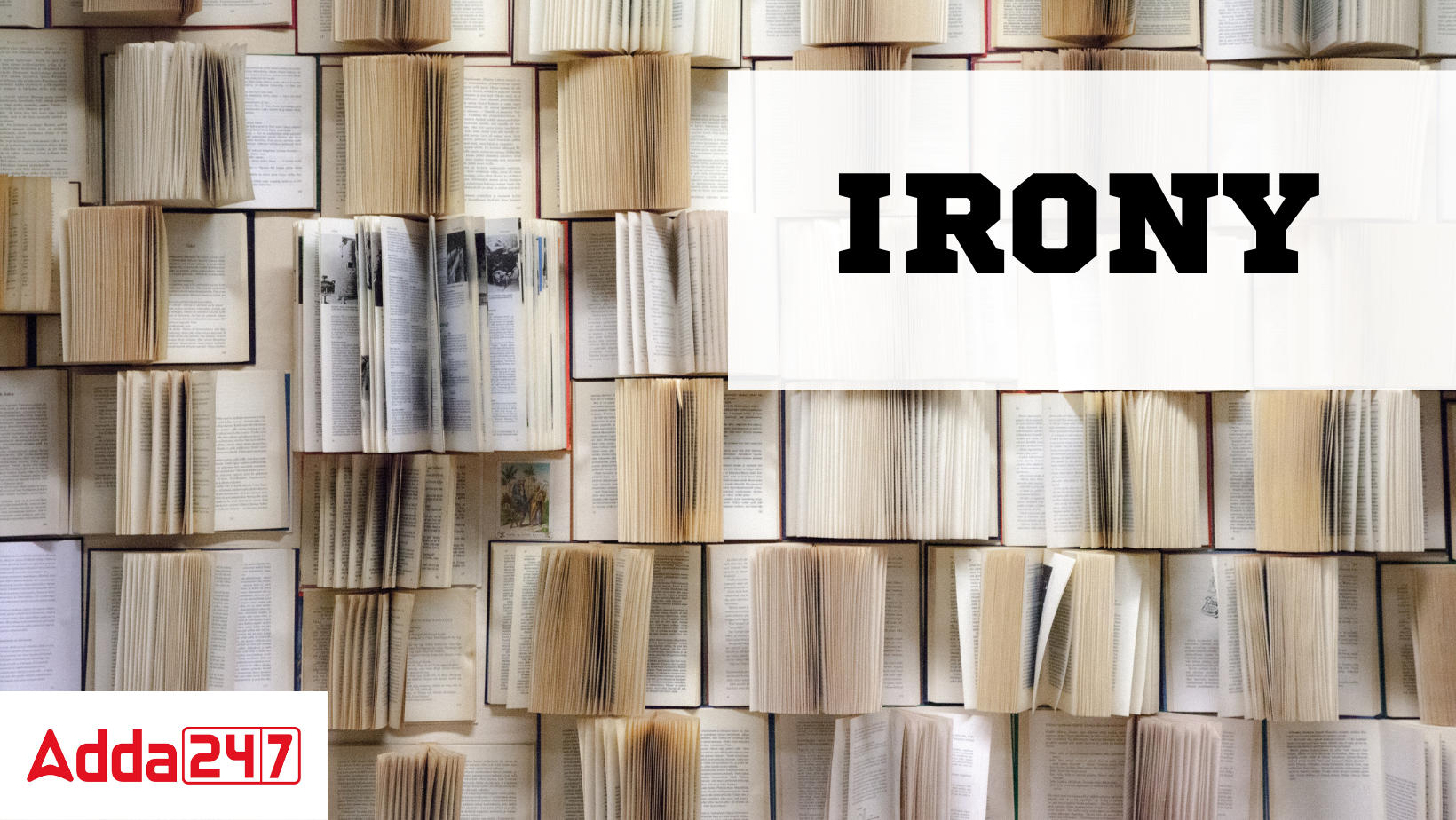Irony Figure of Speech
Irony figure of speech: Irony is a figure of speech in which there is a discrepancy between expectation and actuality is what literary irony is defined as. For instance, the distinction between what something seems to signify and what it actually means. Tragic and comic events are both connected to irony.
The word “irony,” which first appeared in the English language in the sixteenth century, is derived from the Latin word “ironia” and the French word “ironie.” All of these expressions have their roots in Eiron, a stereotypical figure from ancient Greece. An Eiron figure defeats his adversary by exaggerating his weaknesses, partaking in a form of irony by expressing less than what he really means.
Irony Meaning and Definition
Irony is a rhetorical device that is used to communicate a desired message by utilising words that, when read literally, have the opposite meaning. Irony is defined as “the use of words that say the opposite of what you really mean, frequently as a jest and with a tone of voice that conveys this” in the Oxford Learner’s Dictionary.
The Merriam-Webster and Collins dictionaries both define irony as “a subtle type of humour which includes saying something that you do not mean,” and irony as “the use of words to indicate something other than and especially the reverse of the literal meaning.” Irony is defined by the Cambridge Dictionary as “the use of words that are opposed to what you intend, in a funny way.
Types of Irony
When you write a short story, drama, anecdote, or even a novel, you can use one of three basic types of irony. Consider each of the following.
- Dramatic irony is the kind of irony wherein one or more characters in a novel or play are kept in the dark about a crucial piece of information that would drastically affect their lives and completely alter the plot. Dramatic irony keeps readers engaged and interested about the story’s developments. It creates anxiety in the characters, suspense, and empathy in the audience for the story’s characters. Simply put, when dramatic irony is used, the audience is aware of information that the characters have not yet learned or comprehended. Shakespeare is well known for using dramatic irony in the majority of his sad plays. Jonathan Swift, Thomas Hardy, Jane Austen, and Christopher Marlowe are some of the writers who made effective use of dramatic irony in their writings.
- Situational irony occurs when the actions taken by the characters in a play or tale lead to an outcome that is unexpected by the audience. This kind of irony places the play’s or story’s protagonist in a predicament that necessitates paying a high price to achieve their objective. It also helps to add a “twist.” Anyone can appreciate a nice twist, right? The character would be challenged to a whole new level by this circumstance. Additionally, it can be utilised to convey a message or moral to the audience. Some authors that used situational irony well in their writings include Guy de Maupassant, O. Henry, Kate Chopin, Christopher Marlowe, Jane Austen, and William Shakespeare.
- Verbal irony occurs when the author crafts the dialogue of the characters so that the intended meaning is completely at odds with what is actually spoken. Verbal irony, in contrast to the other two types of irony, occurs when the character is aware of the truth but purposefully use irony in a sarcastic manner to reveal the secret truth. The use of verbal irony in the writings of Jonathan Swift, William Shakespeare, Jane Austen, Samuel Taylor Coleridge, Edgar Allen Poe, and George Bernard Shaw is well known.
Irony and Sarcasm
A conversational tactic known as sarcasm involves speaking the exact opposite of what one means. Sarcasm is used in a mocking, sneering, and frequently witty manner. The word sarcasm is derived from the Greek word “sarkázein,” which means to “rip flesh.” This means that it might be intended at someone else in a playful way or be self-deprecating, with the speaker making fun of themselves.
Sarcasm is fundamentally distinct from irony in that it is a feature of speech. Irony can also be used to describe conditions or occurrences. Sarcasm is not a literary construct, but there are several situations in which someone might say something that is both ironic and sarcastic.
Irony Examples
Examples of Dramatic Irony
-
- In the play, ‘Othello’ by William Shakespeare, Iago tries to manipulate Othello into believing that he is an honest man.
“Othello: I think thou dost.
And for I know thou ‘rt full of love and honesty
And weigh’st thy words before thou giv’st them breath…”
-
- William Shakespeare applies dramatic irony in the play ‘Macbeth’ as well. In the below lines, we see King Duncan expressing his absolute trust over Macbeth who would kill him.
“He was a gentleman on whom I built an absolute trust”
-
- In ‘Oedipus Rex’ by Sophocles, you can see Oedipus saying that he would not fail to make sure to find who the murderer of his father is.
“On these accounts I, as for my own father,
Will fight this fight, and follow out every clue,
Seeking to seize the author of his murder.”
Examples of Situational Irony
-
- Samuel Taylor Coleridge uses situational irony in his poem, ‘The Rime of the Ancient Mariner’ in the lines,
“Water, water, every where,
Nor any drop to drink.”
-
- In William Shakespeare’s play, ‘Romeo and Juliet’, you can see a great use of situational irony in the scene where Romeo finds Juliet lying as if dead and so kills himself. He says,
“O my love, my wife! Death, that hath sucked the honey of thy breath, Hath had no power yet upon thy beauty.”
Juliet is seen waking up later to see that Romeo had killed himself, and so kills herself too.
- ‘The Gift of the Magi’ by O. Henry has an apt example of situational irony. The characters in the story – the husband and wife are seen to sell off their priced possessions in order to get the other a gift they would love. They, however, end up buying gifts that both of them can no longer use.
Examples of Verbal Irony
-
- The moment anyone thinks of verbal irony, the first example that comes to mind would be Antony’s speech about Brutus being an honourable man in the play, ‘Julius Caesar’ by William Shakespeare. He is seen to describe all the good that Caesar did and establish that in spite of all that, Antony said that Caesar was ambitious and that he was an honourable man. This is done for quite some time finally letting the audience understand who was in fact behind the death of Julius Caesar.
“I thrice presented him a kingly crown,
Which he did thrice refuse: was this ambition?
Yet Brutus says he was ambitious;
And, sure, he is an honourable man.”
-
- In the novel, ‘Pride and Prejudice’ by Jane Austen, Darcy’s first impression of Elizabeth Bennet was contrary to the final outcome, hence making it an instance of verbal irony. He says, “She is tolerable but not handsome enough to tempt me”, but ends up loving and marrying her in the end.
- In the play, ‘Pygmalion’ by George Bernard Shaw, you can see Mrs. Higgins using verbal irony to react to Prof. Higgins’ attitude and arrogance towards Eliza.
Higgins: ‘Don’t you dare try this game on me. I taught it to you; and it doesn’t take me in. Get up and come home; and don’t be a fool.”
Mrs. Higgins: ‘Very nicely put, indeed, Henry. No woman could resist such an invitation.”
Irony Meaning in Hindi
विडंबना अलंकार: विडंबना भाषण का एक अलंकार है जिसमें अपेक्षा और वास्तविकता के बीच एक विसंगति होती है जिसे साहित्यिक विडंबना के रूप में परिभाषित किया जाता है। उदाहरण के लिए, कोई चीज़ क्या दर्शाती है और वास्तव में उसका क्या अर्थ है, के बीच का अंतर। दुखद और हास्यपूर्ण घटनाएँ दोनों विडंबना से जुड़ी हैं।
“विडंबना” शब्द, जो पहली बार सोलहवीं शताब्दी में अंग्रेजी भाषा में दिखाई दिया, लैटिन शब्द “आयरोनिया” और फ्रांसीसी शब्द “आयरनी” से लिया गया है। इन सभी अभिव्यक्तियों की जड़ें प्राचीन ग्रीस के एक स्टीरियोटाइपिकल आकृति ईरॉन में हैं। एक ईरॉन आकृति अपने विरोधी को उसकी कमजोरियों को बढ़ा-चढ़ा कर परास्त करती है, जो वास्तव में उसका मतलब है उससे कम व्यक्त करके विडंबना के रूप में भाग लेती है।
Irony Definition in Hindi
विडंबना एक आलंकारिक उपकरण है जिसका उपयोग शब्दों का उपयोग करके एक वांछित संदेश संप्रेषित करने के लिए किया जाता है, जब शाब्दिक रूप से पढ़ा जाता है, तो इसका विपरीत अर्थ होता है। ऑक्सफोर्ड लर्नर्स डिक्शनरी में विडंबना को “ऐसे शब्दों के उपयोग के रूप में परिभाषित किया गया है जो आपके वास्तव में मतलब के विपरीत कहते हैं, अक्सर एक मजाक के रूप में और एक स्वर के साथ जो इसे व्यक्त करता है”।
मरियम-वेबस्टर और कोलिन्स शब्दकोष दोनों विडंबना को “एक सूक्ष्म प्रकार के हास्य के रूप में परिभाषित करते हैं जिसमें कुछ ऐसा कहना शामिल है जिसका आप मतलब नहीं है,” और विडंबना “शब्दों के उपयोग के अलावा और विशेष रूप से शाब्दिक अर्थ के विपरीत कुछ इंगित करने के लिए। ” विडंबना को कैम्ब्रिज डिक्शनरी द्वारा “उन शब्दों के उपयोग के रूप में परिभाषित किया गया है जो आपके इरादे का विरोध करते हैं, मजाकिया तरीके से।
Irony Types in Hindi
जब आप एक छोटी कहानी, नाटक, उपाख्यान, या एक उपन्यास भी लिखते हैं, तो आप तीन मूल प्रकार की विडंबनाओं में से एक का उपयोग कर सकते हैं। निम्नलिखित में से प्रत्येक पर विचार करें।
नाटकीय विडंबना उस तरह की विडंबना है जिसमें एक उपन्यास या नाटक में एक या एक से अधिक पात्रों को एक महत्वपूर्ण जानकारी के बारे में अंधेरे में रखा जाता है जो उनके जीवन को काफी प्रभावित करेगा और कथानक को पूरी तरह से बदल देगा। नाटकीय विडंबना पाठकों को बांधे रखती है और कहानी के विकास के बारे में रुचि रखती है। यह कहानी के पात्रों के लिए पात्रों में चिंता, रहस्य और दर्शकों में सहानुभूति पैदा करता है। सीधे शब्दों में कहें, जब नाटकीय विडंबना का उपयोग किया जाता है, तो दर्शकों को जानकारी के बारे में पता चलता है कि पात्रों ने अभी तक सीखा या समझा नहीं है। शेक्सपियर अपने अधिकांश उदास नाटकों में नाटकीय विडंबनाओं का उपयोग करने के लिए जाने जाते हैं। जोनाथन स्विफ्ट, थॉमस हार्डी, जेन ऑस्टेन और क्रिस्टोफर मार्लो कुछ ऐसे लेखक हैं जिन्होंने अपने लेखन में नाटकीय विडंबना का प्रभावी उपयोग किया है।
परिस्थितिजन्य विडंबना तब होती है जब किसी नाटक या कहानी में पात्रों द्वारा किए गए कार्य एक ऐसे परिणाम की ओर ले जाते हैं जो दर्शकों द्वारा अप्रत्याशित होता है। इस तरह की विडंबना नाटक या कहानी के नायक को ऐसी दुर्दशा में डाल देती है जो अपने उद्देश्य को प्राप्त करने के लिए उच्च कीमत चुकाने की आवश्यकता होती है। यह “ट्विस्ट” जोड़ने में भी मदद करता है। कोई भी अच्छे मोड़ की सराहना कर सकता है, है ना? इस परिस्थिति से चरित्र को एक नए स्तर पर चुनौती दी जाएगी। इसके अतिरिक्त, इसका उपयोग दर्शकों को संदेश या नैतिक संदेश देने के लिए किया जा सकता है। कुछ लेखकों ने अपने लेखन में स्थितिजन्य विडंबना का अच्छी तरह से उपयोग किया है, जिसमें गाइ डे मौपासेंट, ओ. हेनरी, केट चोपिन, क्रिस्टोफर मार्लो, जेन ऑस्टेन और विलियम शेक्सपियर शामिल हैं।
मौखिक विडंबना तब होती है जब लेखक पात्रों के संवाद को शिल्प करता है ताकि इच्छित अर्थ वास्तव में बोली जाने वाली बातों से पूरी तरह से अलग हो। मौखिक विडंबना, अन्य दो प्रकार की विडंबनाओं के विपरीत, तब होती है जब चरित्र सच्चाई से अवगत होता है लेकिन गुप्त सत्य को प्रकट करने के लिए व्यंग्यात्मक तरीके से विडंबना का उपयोग करता है। जोनाथन स्विफ्ट, विलियम शेक्सपियर, जेन ऑस्टेन, सैमुअल टेलर कोलरिज, एडगर एलन पो और जॉर्ज बर्नार्ड शॉ के लेखन में मौखिक विडंबना का उपयोग सर्वविदित है।
Irony Figure of Speech in Hindi
कटाक्ष के रूप में जानी जाने वाली एक संवादी युक्ति में एक के अर्थ के ठीक विपरीत बोलना शामिल है। कटाक्ष का उपयोग उपहास, उपहास और अक्सर मजाकिया तरीके से किया जाता है। कटाक्ष शब्द ग्रीक शब्द “सरकाज़िन” से लिया गया है, जिसका अर्थ है “मांस को चीरना”। इसका मतलब है कि यह किसी और के लिए चंचल तरीके से अभिप्रेत हो सकता है या आत्म-हीन हो सकता है, जिसमें वक्ता खुद का मज़ाक उड़ाता है।
कटाक्ष मौलिक रूप से विडंबना से अलग है क्योंकि यह भाषण की एक विशेषता है। विडंबना का उपयोग स्थितियों या घटनाओं का वर्णन करने के लिए भी किया जा सकता है। कटाक्ष एक साहित्यिक निर्माण नहीं है, लेकिन ऐसी कई स्थितियाँ हैं जिनमें कोई व्यक्ति कुछ ऐसा कह सकता है जो विडंबनापूर्ण और व्यंग्यात्मक दोनों हो।
Irony Examples in Hindi
नाटकीय विडंबना के उदाहरण
विलियम शेक्सपियर के नाटक ‘ओथेलो’ में, इयागो ने ओथेलो को यह विश्वास दिलाने के लिए हेरफेर करने की कोशिश की कि वह एक ईमानदार आदमी है।
“ओथेलो: मुझे लगता है कि आप करते हैं।
और क्योंकि मैं जानता हूं कि तुम प्यार और ईमानदारी से भरे हुए हो
और उन्हें सांस देने से पहले अपने शब्दों को तौलें… ”
विलियम शेक्सपियर नाटक ‘मैकबेथ’ में भी नाटकीय विडंबना लागू करते हैं। नीचे की पंक्तियों में, हम राजा डंकन को मैकबेथ पर अपना पूर्ण विश्वास व्यक्त करते हुए देखते हैं जो उसे मार डालेगा।
“वह एक सज्जन व्यक्ति थे जिन पर मैंने एक पूर्ण विश्वास बनाया”
सोफोकल्स द्वारा ‘ओडिपस रेक्स’ में, आप ओडिपस को यह कहते हुए देख सकते हैं कि वह यह सुनिश्चित करने में विफल नहीं होगा कि उसके पिता का हत्यारा कौन है।
“इन बातों पर मैं, मेरे अपने पिता के लिए के रूप में,
इस लड़ाई को लड़ेंगे, और हर सुराग का पालन करेंगे,
उनकी हत्या के लेखक को जब्त करने की मांग।
परिस्थितिजन्य विडंबना के उदाहरण
सैमुअल टेलर कॉलरिज ने अपनी कविता ‘द राइम ऑफ द एंशिएंट मेरिनर’ में स्थितिजन्य विडंबना का इस्तेमाल इन पंक्तियों में किया है,
“पानी, पानी, हर जगह,
न ही पीने के लिए एक बूंद।”
विलियम शेक्सपियर के नाटक, ‘रोमियो एंड जूलियट’ में, आप उस दृश्य में स्थितिजन्य विडंबना का एक बड़ा उपयोग देख सकते हैं जहाँ रोमियो जूलियट को मरा हुआ पाता है और इसलिए खुद को मार डालता है। वह कहता है,
“हे मेरे प्रिय, मेरी पत्नी! मृत्यु, जिसने तेरी श्वास का मधु चूस लिया है, तेरी सुन्दरता पर अब तक उसका कुछ भी अधिकार न रहा।”
जूलियट बाद में जागते हुए देखती है कि रोमियो ने खुद को मार डाला था, और इसलिए खुद को भी मारती है।
ओ हेनरी द्वारा लिखित ‘द गिफ्ट ऑफ द मैगी’ में परिस्थितिजन्य विडंबना का एक उपयुक्त उदाहरण है। कहानी के पात्र – पति और पत्नी दूसरे को अपनी पसंद का उपहार पाने के लिए अपनी कीमती संपत्ति बेच देते हैं। हालाँकि, अंत में वे ऐसे उपहार खरीद लेते हैं जिनका वे दोनों अब उपयोग नहीं कर सकते।
मौखिक विडंबना के उदाहरण
जिस क्षण कोई मौखिक विडंबना के बारे में सोचता है, पहला उदाहरण जो दिमाग में आता है वह विलियम शेक्सपियर द्वारा ‘जूलियस सीज़र’ नाटक में ब्रूटस के एक सम्मानित व्यक्ति होने के बारे में एंटनी का भाषण होगा। उन्हें सीज़र द्वारा किए गए सभी अच्छे कामों का वर्णन करने और स्थापित करने के लिए देखा जाता है, एंटनी ने कहा कि सीज़र महत्वाकांक्षी था और वह एक सम्मानित व्यक्ति था। यह कुछ समय के लिए किया जाता है, अंत में दर्शकों को यह समझने देता है कि वास्तव में जूलियस सीज़र की मृत्यु के पीछे कौन था।
“मैंने उसे तीन बार राजमुकुट भेंट किया,
जिसे उन्होंने तीन बार मना किया: क्या यह महत्वाकांक्षा थी?
फिर भी ब्रूटस कहता है कि वह महत्वाकांक्षी था;
और निश्चित रूप से, वह एक सम्मानित व्यक्ति हैं।”
Irony Figure of Speech FAQs
Que. What is an irony example?
Ans. Irony is defined as “the use of words that say the opposite of what you really mean.
Que. What is a simple definition of irony?
Ans. Irony is a figure of speech in which there is a discrepancy between expectation and actuality.
Que. Why is it called irony?
Ans. The term irony has its roots in the Greek comic character Eiron, a clever underdog who by his wit repeatedly triumphs over the boastful character Alazon.
Que. Is irony positive or negative?
Ans. Irony is always negative.
Que. What is difference between irony and satire?
Ans. Irony is a figure of speech which depicts the opposite of the truth through the careful play of words and wit. Satire is a literary form or genre widely used in the use or performance of graphic arts.









 RRBMU Result 2025 OUT, Get Matsya Univer...
RRBMU Result 2025 OUT, Get Matsya Univer...
 Best CUET Coaching in Delhi: Reasons to ...
Best CUET Coaching in Delhi: Reasons to ...
 Best CUET Coaching in Noida- Know Locati...
Best CUET Coaching in Noida- Know Locati...










